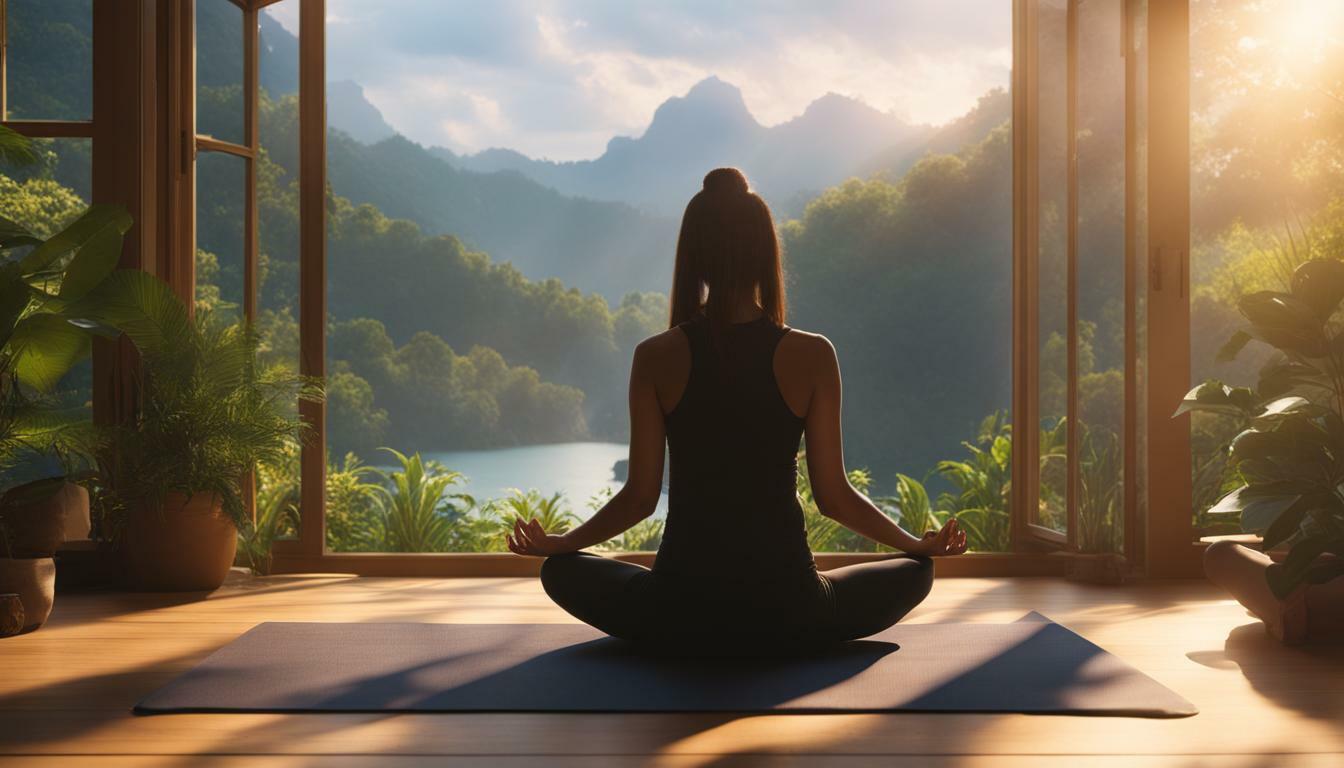Welcome to our comprehensive guide on how to prepare for meditation effectively. Discover the transformative power of mindfulness and learn the essential steps to create the ideal meditation environment.
Mastering mindfulness is about learning how to pay attention to the present moment without judgment. It involves focusing on the breath and returning to it whenever the mind wanders. Meditation has many benefits, such as reducing stress, improving focus, and lowering brain chatter.
To prepare for meditation, find a calm and quiet place to sit, set a time limit, and notice your breath. When thoughts arise, gently bring your attention back to the breath. It is recommended to meditate for at least 12 minutes, 5 days a week.
Mindfulness can also be practiced in various ways, such as paying attention to the body, thoughts, and emotions. It’s important to be patient, as meditation is a skill that requires regular practice.
Some common challenges in meditation include mental noise, lack of patience, lack of time, and lack of guidance. Mindfulness exercises can be done anywhere and anytime, and they help in managing stress and enjoying simple pleasures. More structured mindfulness exercises, such as body scan meditation and sitting meditation, require finding a quiet place and setting aside dedicated time.
Remember, practicing mindfulness is an ongoing journey. It is advised to practice mindfulness exercises every day for about six months to experience its full benefits.
Key Takeaways:
- Prepare for meditation by finding a calm and quiet place
- Set a time limit and focus on your breath
- Meditate for at least 12 minutes, 5 days a week
- Be patient, as meditation requires regular practice
- Overcome common challenges in meditation with mindfulness exercises
Benefits of Meditation and Mindfulness Techniques
Explore the myriad benefits of meditation and discover powerful mindfulness techniques that can help you relax, focus, and cultivate a sense of inner peace. Meditation is an ancient practice that has been proven to have numerous positive effects on the mind and body. By incorporating meditation into your daily routine, you can experience reduced stress levels, improved concentration, and enhanced overall well-being.
Mindfulness exercises are an integral part of meditation, allowing you to become more aware of the present moment and develop a deeper connection with yourself. One such technique is the body scan meditation, where you systematically bring your attention to each part of your body, noticing any sensations or areas of tension. This practice promotes relaxation and helps you become more attuned to your physical sensations.
| Meditation Technique | Description |
|---|---|
| Sitting Meditation | A practice where you sit in a comfortable position and focus your attention on your breath, allowing thoughts to come and go without judgment. |
| Loving-Kindness Meditation | A technique aimed at cultivating feelings of love, compassion, and kindness towards oneself and others. |
| Walking Meditation | A form of meditation where you focus on the sensations in your body as you walk, staying present and aware of your surroundings. |
These mindfulness exercises can be practiced anywhere and at any time, making them accessible and convenient for even the busiest individuals. By incorporating mindfulness into your daily life, you can learn to manage stress more effectively, improve your focus and concentration, and find joy in the simple pleasures that surround you.
Quotes from experts:
“Meditation is like a gym in which you develop the powerful mental muscles of calm and insight.” – Ajahn Brahm
Key takeaways:
- Meditation has numerous benefits, including stress reduction and improved focus.
- Mindfulness exercises, such as body scan meditation, can enhance your awareness of the present moment.
- Various meditation techniques, such as sitting, loving-kindness, and walking meditation, offer different approaches to cultivating mindfulness.
- Quotes from experts highlight the transformative power of meditation.
- Incorporating mindfulness into your daily life can help you manage stress and find joy in simple pleasures.
Creating the Perfect Meditation Space
Prepare yourself for a sublime meditation experience by creating a tranquil space that caters to your mental and physical well-being. Having a dedicated meditation space can help you create a peaceful environment where you can fully immerse yourself in the practice of mindfulness. Let’s explore some simple steps to transform any area into a serene sanctuary for your meditation practice.
Declutter and Simplify
Start by decluttering the space to create a clean and calming atmosphere. Remove any unnecessary items or distractions that may hinder your focus. A clutter-free environment promotes clarity of mind and allows for a more profound meditation experience. Consider incorporating minimalistic decor and soft colors to enhance the sense of tranquility.
Set the Mood
Add elements that promote relaxation and serenity. Soft lighting, such as candles or dimmable lamps, can create a soothing ambiance. Natural light is also beneficial, so position your meditation space near a window if possible. Consider using essential oils or incense to infuse the air with calming scents, such as lavender or sandalwood. The aroma can help induce a sense of calmness and relaxation.
Make it Comfortable
Choose a comfortable and supportive cushion or meditation chair to sit on. The goal is to find a position that allows you to maintain a straight spine while being at ease. You may also want to add a blanket or shawl to provide warmth and create a cozy atmosphere. The key is to create a space that encourages relaxation and deepens your connection with the present moment.
Final Thoughts
Creating a dedicated meditation space is an investment in your well-being. It allows you to cultivate a consistent meditation practice and reap the full benefits of mindfulness. Remember, finding a calm and quiet place, decluttering, setting the mood, and making the space comfortable are all essential elements to consider. Take the time to create a space that speaks to your soul and supports your journey towards inner peace and clarity.
| Key Points | Benefits |
|---|---|
| Declutter and simplify the space | – Promotes clarity of mind – Creates a calming atmosphere |
| Set the mood | – Enhances relaxation and serenity – Invokes a soothing ambiance |
| Make it comfortable | – Allows for a relaxed and supported posture – Creates a cozy atmosphere |
Overcoming Common Challenges in Meditation
Discover valuable tips and techniques to overcome common challenges that may arise during your meditation journey, empowering you to cultivate a more focused and peaceful mind.
When you embark on your meditation practice, you may encounter obstacles that can disrupt your concentration and hinder your progress. However, with the right strategies, you can overcome these challenges and deepen your meditation experience. Here are some tips to help you navigate common hurdles:
- Mental Noise: The mind naturally produces thoughts and distractions, making it difficult to stay focused during meditation. Instead of getting frustrated, view these thoughts as passing clouds in the sky. Gently acknowledge them and let them go, redirecting your attention back to your breath.
- Lack of Patience: Meditation is a skill that requires patience and practice. Understand that progress takes time and that it’s normal to have good and bad meditation sessions. Be kind to yourself and persist in your practice, even when it feels challenging.
- Lack of Time: Finding time for meditation can be a struggle in our busy lives. Start with short sessions and gradually increase the duration as you get more comfortable. Consider incorporating meditation into your daily routine, such as during your morning or evening rituals, so it becomes a regular habit.
- Lack of Guidance: If you feel unsure about your meditation technique or need guidance, seek support from experienced practitioners, meditation apps, or online resources. Sometimes, having a teacher or a community can provide valuable insights and encouragement on your meditation journey.
Remember, meditation is a personal practice, and everyone’s experience is unique. Be open to exploring different techniques and finding what works best for you. By persisting through challenges, you will develop resilience and cultivate a more focused and peaceful mind.
Tips for Overcoming Common Challenges
To help you navigate the common challenges in meditation, keep these tips in mind:
“The present moment is all you ever have. There is never a time when your life is not ‘this moment.’” – Jon Kabat-Zinn
- Stay consistent: Establish a regular meditation schedule and stick to it. Consistency is key in building a strong meditation practice.
- Start small: Begin with shorter meditation sessions, such as 5-10 minutes, and gradually increase the duration as you build your focus and endurance.
- Find support: Seek guidance from meditation teachers, join meditation groups, or use meditation apps to deepen your practice and gain valuable insights.
- Be gentle with yourself: Let go of expectations and judgments. Accept that some meditation sessions will be more challenging than others, and that’s okay.
By implementing these tips and techniques, you can overcome common challenges in meditation and experience the transformative power of a focused and peaceful mind.
| Challenge | Solution |
|---|---|
| Mental Noise | Observe thoughts without attachment and redirect focus to the breath |
| Lack of Patience | Embrace the process, be kind to yourself, and persist in your practice |
| Lack of Time | Start with short sessions and incorporate meditation into your daily routine |
| Lack of Guidance | Seek support from experienced practitioners, meditation apps, or online resources |
Incorporating Mindfulness into Daily Life
Extend the benefits of mindfulness beyond your meditation cushion and learn how to cultivate a mindful approach to every aspect of your daily life. Mindfulness is not limited to formal meditation sessions; it can be practiced throughout the day, enhancing your overall well-being and inner peace. By paying attention to the present moment without judgment, you can experience greater clarity, reduced stress, and increased joy in the simple pleasures of life.
One way to incorporate mindfulness into your daily routine is by bringing awareness to your body, thoughts, and emotions. Take a moment to check in with yourself regularly, noticing any areas of tension or discomfort in your body. Tune in to your thoughts and emotions, observing them without getting caught up in their stories or judgments. This practice of self-awareness can help you navigate through daily challenges with greater ease and equanimity.
Additionally, there are various mindfulness exercises that you can seamlessly integrate into your daily activities. For example, you can practice mindful eating by savoring each bite of your meal, paying attention to the flavors, textures, and sensations in your mouth. Mindful walking is another powerful exercise, where you focus on the sensation of your feet touching the ground and the rhythm of your steps.
To deepen your mindfulness practice, you may also consider incorporating more structured meditation sessions into your routine. Body scan meditation involves systematically bringing attention to different parts of your body, cultivating a sense of relaxation and presence. Sitting meditation, on the other hand, involves finding a quiet place and dedicating time to sit in stillness, observing your breath and the thoughts that arise.
Remember, mindfulness is a skill that requires consistent practice and patience. Start by dedicating a few minutes each day to mindfulness exercises, gradually working your way up to longer sessions. Research suggests that practicing mindfulness for about six months can lead to significant improvements in overall well-being.
What Are Some Tips for Using a Meditation Bowl Effectively in My Mindfulness Practice?
To maximize the benefits of your mindfulness practice, using a meditation bowl effectively can be extremely helpful. Begin by finding a quiet and peaceful space, where you can focus without distractions. Hold the bowl gently in one hand and the mallet in the other, striking the bowl’s edge with a firm yet gentle tap. Allow the soothing sound to fill the room, capturing your attention and calming your mind. Embrace the serene vibrations and let your thoughts gradually fade away. Practice this technique regularly to enhance your meditation experience.
FAQ
What is mindfulness?
Mindfulness is the practice of paying attention to the present moment without judgment. It involves focusing on the breath and returning to it whenever the mind wanders.
What are the benefits of meditation?
Meditation has many benefits, including reducing stress, improving focus, and quieting the mind.
How should I prepare for meditation?
To prepare for meditation, find a calm and quiet place to sit, set a time limit, and focus on your breath. When thoughts arise, gently bring your attention back to the breath.
How long should I meditate for?
It is recommended to meditate for at least 12 minutes, 5 days a week.
How can I practice mindfulness in daily life?
Mindfulness can be practiced by paying attention to your body, thoughts, and emotions throughout the day. You can also incorporate mindfulness exercises into your daily routines to manage stress and find joy in simple pleasures.
What are some common challenges in meditation?
Some common challenges in meditation include mental noise, lack of patience, lack of time, and lack of guidance.
How can I overcome these challenges?
Overcoming these challenges requires patience and regular practice. It may be helpful to seek guidance from meditation teachers or use meditation apps that provide guided sessions.








